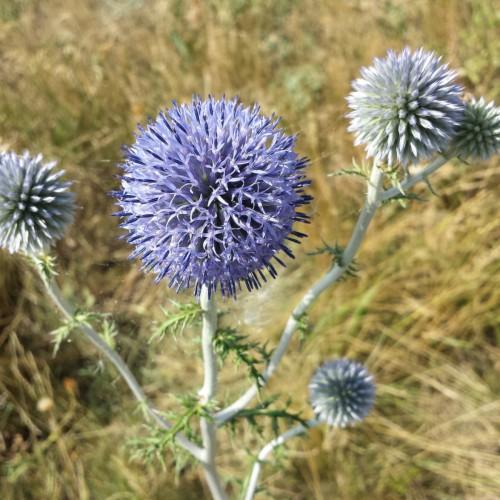
small globe thistle
Echinops ritro subsp. ruthenicus
Cycle:
Herbaceous Perennial
Watering:
Minimum
Hardiness Zone:
4 - 8
Flowers:
Flowers
Sun:
Full sun
Leaf:
Yes
Growth Rate:
Low
Maintenance:
Low
Drought Tolerant:
Yes
Salt Tolerant:
Yes
Thorny:
Yes
watering
Small globe thistle plants should be watered every 8-10 days to a depth of 1-2 inches. Water should be applied in the morning when the soil is slightly moist. Avoid over-watering to prevent root rot. During periods of extreme heat or drought, water more frequently; during cooler and wetter seasons, you can reduce watering. When the soil has dried out to about 2 inches deep, it's time to water again. Applying a layer of mulch around the plant will help the soil retain moisture and reduce weeds.
sunlight
Small globe thistle is a sun-loving plant species that needs at least 8 hours of direct sunlight each day to grow and thrive. It is a plant native to Central Europe, found in countries such as Germany, Austria, and the Czech Republic. This plant species is best suited to growing in sunny, well-drained soil and prefers to get its sunlight in the morning and early afternoon. For optimal growth, small globe thistle should be exposed to full sun between the hours of 10 a.m. and 2 p.m. daily. Even brief exposures to direct sunlight during the day can still help the plant to grow. However, during the summer months, the plant should be protected from intense afternoon sun and bright air exposure as it can result in leaf damage. Lastly, it is important to note that small globe thistle is not tolerant of shady conditions, and may not grow adequately if it is not getting the right amount and type of sunlight.
pruning
Small globe thistle (Echinops ritro subsp. ruthenicus) should be pruned lightly as required in order to keep the plant neat and tidy. Any dead or diseased foliage should be removed as soon as possible. Pruning should begin in late spring (May or June) when the plant has produced enough foliage for shaping, but hasn't yet begun to flower. Remove any thin or weak shoots, leaving any strong central stems. Continue to prune lightly in July, removing any flower heads and thinning out the foliage as necessary. Finally, a final pruning should be done in late summer (August) to shape the plant and reduce the size.
